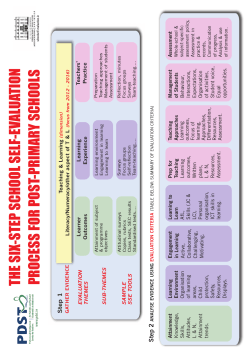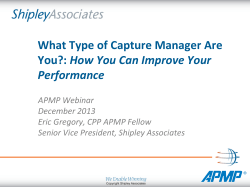
Due Date: February 11, 2015 Lesson Four – Chapter 4 Assessing
BMGT 2341 Strategic Management Spring 2015 Due Date: February 11, 2015 Lesson Four – Chapter 4 Assessing Strengths and Weaknesses: Doing an Internal Analysis Instructions: Create an answer sheet for this lesson. Choose the one best answer for multiple choice questions. Use complete sentences for essay questions. Include examples from your own experience to illustrate or explain your answer. Examples should be from your own experience or the experience of someone you know personally – not the examples provided in the textbook. Points will be deducted if a personal example is not incorporated in your answer. Email your answer sheet to me at cnicholsoc2015@gmail.com True/False Questions: 3 points each _____ 1) An organization's tangible and intangible resources can be a source of competitive advantage and these resources play an important role in determining an organization's capabilities and competencies. _____ 2) Customer value arises from the similarity of products to others, the product is lowpriced, and the ability of the organization to respond to customer needs. _____ 3) Value chain analysis is a systematic way of examining all the organization's functional activities and how well they create customer value. _____ 4) An external audit is a thorough assessment of an organization's various internal functional areas. _____ 5) Preparing a current product-market profile emphasizes organization-customer interactions. _____ 6) Identifying and agreeing on the key competencies and capabilities is critical to managing strategically for a sustainable competitive advantage. _____ 7) One criterion that could be used to determine whether resources and capabilities are strengths or weaknesses is past performance trends. _____ 8) Every organization needs goals at all levels and in all functional areas that state what it hopes to accomplish by when. _____ 9) Doing an internal analysis is needed for making good strategic decisions. _____ 10) Weaknesses are resources and capabilities that are lacking or deficient and that prevent the organization from developing a sustainable competitive advantage. BMGT 2341 Strategic Management Spring 2015 Multiple Choice Questions: Select the one best answer. 3 points each _____ 11) Factors like Coca-Cola's brand name "Coke" and Nike's "swoosh" symbol construct ________ resources for the organization. A) physical B) intangible C) financial D) invisible E) human _____ 12) The various organizational routines and processes that determine how efficiently and effectively the organization transforms its inputs into outputs are called A) strengths. B) core competencies. C) capabilities. D) customer value. E) operations. _____ 13) ________ are the regular, predictable, and sequential patterns of work activities performed by organizational members. A) Organizational capabilities B) Accumulated knowledge C) Actual work activities D) Organizational routines and processes E) None of the answer choices is correct. _____ 14) Southwest's capability of quick gate turnaround time and exceptional employeecustomer interactions is known as A) a distinctive organizational capability. B) an exceptional opportunity. C) a superior customer value. D) a distinguished service. E) None of the answer choices is correct. _____ 15) The ability of Hampton Inn to provide customers moderately-priced accommodation with all the amenities and conveniences travelers want is an example of A) contributing to superior customer value. B) a second-to-market philosophy. C) operating under a benchmarking philosophy. D) providing a system that is easily duplicated. E) None of the answer choices is correct. BMGT 2341 Strategic Management Spring 2015 _____ 16) The ability of Honda to use its fuel-efficient and reliable engines in automobiles, motorcycles, and power generators is an example of A) contributing to superior customer value. B) creating a product that is difficult for competitors to imitate. C) developing an innovation that can be used in a number of ways. D) simulating an effective system developed by a competitor. E) making a product with a low amount of financial capital. _____ 17) Core competencies cannot be a source of ________, but can contribute to the development of ________. A) organizational goals; competitive advantage B) dynamic capabilities; internal analysis. C) competitive advantage; distinctive capabilities. D) distinctive capabilities; organizational goals E) None of the answer choices is correct. _____ 18) Customer value is determined by A) a unique and different product. B) a low-priced product. C) ability to respond to specific or distinct customer needs. D) All of the answer choices are correct. E) None of the answer choices is correct. _____ 19) Which of the following are considered to be primary activities in a value chain analysis as outlined by Porter? A) Inbound logistics B) Procurement C) Human resource management D) Firm's infrastructure E) None of the answer choices is correct _____ 20) Performance of ________ activities would not be possible without ________ activities. A) core; support B) primary; support C) support; primary D) strategic; support E) support; core BMGT 2341 Strategic Management Spring 2015 _____ 21) The internal audit answers the questions of A) Do the various functions have the needed resources to perform their assigned work activities? B) How well do they perform these assigned work activities? C) What are the organization's primary opportunities and threats? D) possessing the needed resources and then performing assigned work activities. E) None of the answer choices is correct. _____ 22) Which of the following is one of the basic organizational functions managers should examine during an internal audit? A) Production-operations B) Marketing C) Financial-accounting D) Information systems E) All of the answer choices are correct _____ 23) All of the following reflect questions asked of the management function during the internal audit except A) Are jobs effectively designed? B) What is the level of employee turnover? C) Is the organization able to raise long-term capital? D) How does the organization treat its employees? E) Does the organization effectively use work teams? _____ 24) The question, "Does the capability provide tangible customer benefits?" occurs under what step of the capabilities assessment profile which identifies distinctive organizational capabilities? A) Sort the core capabilities and competencies according to strategic importance. B) Identify and agree on the key capabilities and competencies. C) Describe all the organizational capabilities and competencies. D) Prepare current product-market profile. E) None of the answer choices are correct. _____ 25) Why is an internal analysis important? A) It is the only way to identify an organization's strengths and weaknesses. B) It is needed for making good strategic decisions. C) It establishes organizational goals. D) It identifies strengths and weaknesses and it assists in decision making. E) Answers B and D are correct. BMGT 2341 Strategic Management Spring 2015 Situation Questions: 3 points each Nikki Krisak, a talented, well-established interior designer in the Pacific Northwest, has decided to do internal analysis of her company, Northland Designs. You have been asked to advise Ms. Krisak in analyzing her company's strengths and weaknesses. _____ 1) Northland Designs' ability to stay on the cutting edge of home interior trends throughout the company is called A) a distinctive organizational capability. B) a competitive intelligence. C) a core weakness. D) a core competency. E) a core opportunity. _____ 2) Northland Designs always seems to be combine styles in compelling ways that distinguishes this company from its competitors. This ability is called A) a distinguished organizational capability. B) a distinctive organizational capability. C) a demonstrated organizational capability. D) a denoted organizational capability. E) a delineated organizational capability. _____ 3) Ms. Krisak studies the internal audit to determine the availability or lack of critical ________ and the level of ________. A) capital; skills B) resources; capabilities C) financial resources; management D) skills; resources. E) None of the answer choices is correct. _____ 4) Ms. Krisak asks the question, "Does the ability to stay on the cutting edge of home interior trends provide our customer tangible benefits?" Under which step of the capabilities assessment profile are distinctive organizational capabilities identified? A) Sort the core capabilities and competencies according to strategic importance. B) Identify and agree on the key capabilities and competencies. C) Describe all the organizational capabilities and competencies. D) Prepare current product-market profile. E) None of the answer choices are correct. Essay Questions: 6.5 points each 1) What are core competencies? 2) Describe the criteria involved in judging organizational strengths and weaknesses. BMGT 2341 Strategic Management Spring 2015 Bonus: 20 points If you want more in-depth study of the material in this chapter, you may answer all the questions at the end of Case #2: The Fizz Factor found on page 113 of the text for bonus points for Lesson Four.
© Copyright 2025









